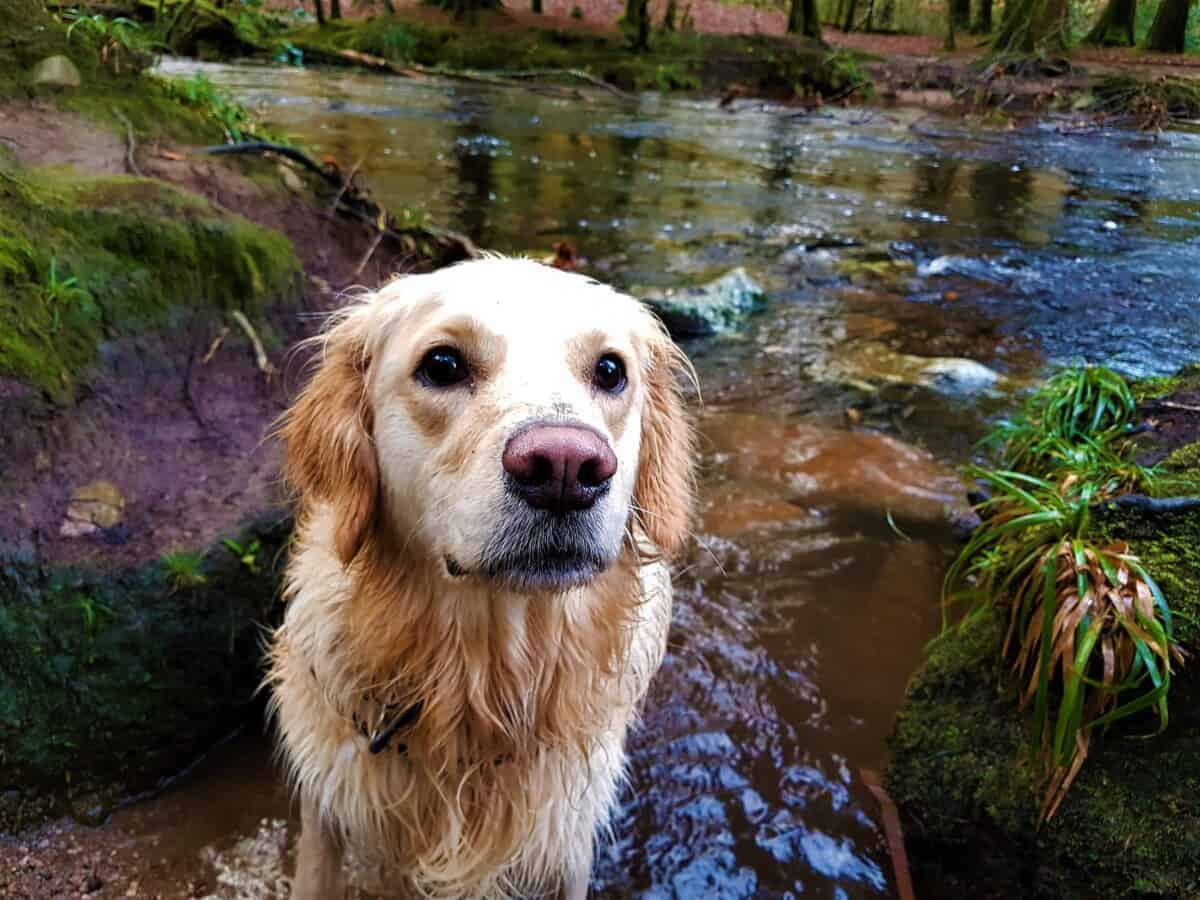Whether it’s taking them out in the rain, letting them swim, or giving them a bath, all owners will face drying their dog at some point. As this is such a common part of owning a dog here are 5 ways to dry a dog.
- Microfibre towels
- Dog Drying Coat
- Adjust Your Walk
- Use A Hairdryer
- Warm Your Room Up
Walking your dog can be great fun and there are lots of places they can get wet, so drying them is an important aspect. In this article, I go through each of the best ways to dry your dog and touch on some extra points you may want to know.
Contents
1. Microfibre Towels
Microfibre towels are the way forward, I have a couple I use on my dog and some that I take traveling or hiking. Whether my dog has got wet on a walk or because I have bathed them I still love to use a microfibre towel. These towels are super absorbent and don’t take long to dry.
When it comes to taking your dog away with you on holiday or even hiking in the local hills, microfibre towels are extremely lightweight and can be stored in a fairly small space. This makes them ideal for hiking, where you may not be able to take much with you…..in my eyes, it leaves more room for food.
These have become very popular towels and you can get them in many places. They are also fairly inexpensive, which allows you to buy ones of varying sizes. I especially like the larger ones to wrap my dog in, as it helps to dry his whole body with less effort from me.
2. Dog Drying Coats
If there is such thing as drying innovation then this is it, although the attempt maybe innovative the result is not totally satisfactory. Drying coats are a great idea and something that I have purchased myself, but they do have some limitations.
A dog drying coat is usually made from microfibre and attaches around your dog just like a normal dog coat. The idea is then that your dog can wander around the house with the towel soaking up most of the water from his coat.
There are however some issues I find with these coats and they do all seem to have the same design process built-in. Firstly the coat wraps over the dog with a microfibre strap going underneath the dog’s belly and around his chest. This is all very well and good if you want your dogs back to be dry but as many owners will know, if your dog has been in the river or bath the majority of water is dripping from their belly. This results in a very soggy wet microfibre strap.
The possible solution is to give them a quick dry underneath before putting the towel on them, which is probably the intention of the designers. However, at this point, I may as well dry the rest of my dog and settle him down on some thick towels. For short-haired or little dogs, the issue is not so bad and works great for drying the majority of your dog without any effort from you. Long-haired dogs still struggle, because the water travels to their belly fur and fills up like a sponge, especially on double-coated breeds.
It’s an excellent idea, which just needs some adjustments to the design to cater to doggy swimmers and long-haired pooches.
3. Adjust Your Walk
This method of drying can be surprisingly effective. Many times when I have been walking my dog I have let him play in the river and get soaking wet. Because he is a double-coated golden retriever he absorbs most of the water he plays in and subsequently carries it back with him.
I have found that my adjust my route after my dog has been swimming can sometimes allow him to dry off by the time we get home. If you are walking on a sunny or windy day then these conditions create the perfect time to consider adjusting your route.
Think about your route back home and try to elevate yourself to a more windy location, if you can walk in the wind for a decent amount of time, depending on your dog they may well be dry by the time you’re home. The same thing goes for the sun. The Sun is a great tool for drying things and your dog is no exception. try walking in the sunshine for a bit to help your pooch dry off, be careful of overexposure, and wear sun cream when necessary.
Different breeds with different coats will dry off at different rates and by combining both sun and wind you will have a dry dog in no time. The final thought on this is the environment and the fact of the matter is, this drying method is completely carbon neutral, a natural and free way to dry your dog…..and even yourself.
4. Use A Hairdryer
Hairdryers are used by professional groomers and give the opportunity to completely dry your dog’s fur leaving them smelling less like dogs. Dogs have hair follicles that release odors when wet, the longer your dog is wet the more the odor will stink.
Using a hairdryer at home can save you a lot of time and get your dog looking great after a bath. It can be frustrating that after a bath your dog still smells and this is down to that odor that is released when wet. If you want your dog to smell more like the shampoo you used to bathe them in, then consider using a hairdryer to quickly dry their fur.
You can of course just use a normal hairdryer you would use on yourself or one that is specifically used to dry dogs. These dryers are a bit more powerful and can cost a lot more money than a normal hairdryer. The idea of them is that they blow more air allowing for a larger area to be dried quicker. Be sure to keep the hairdryer at least 2 – 3 inches away from your dogs fur and be cautious of the temperature you use the hotter the air the further away you need to be.
5. Warm Your Room Up
One method I have found to be effective is simply keeping your house warm. I find that my dog will often lick himself dry and so if I’m short on time I will put the heating on and lay some blankets down. In approximately an hour my dog is able to come in from the kitchen and sit in the lounge with us.
Dogs are very sensitive to temperature, too hot they start panting to cold the curl up to keep warm. Keeping a warm room is not something I would do in the summer months or even late spring, but consider the temperature outside. If your dog could benefit from a cozy warm room then turn the heating on and let them dry out on their own.
In the winter months, we enjoy putting the log burner on and so does our pooch. We have a fan that runs on heat, which allows it to blow hot air out into the room. Anything that needs drying will soon dry with this little gadget and that includes our dog. As a side note make sure NOT to put dog beds near fires, as many of them will burn extremely well and accidents do happen.
How To Dry Your Dog After A Bath
The best way to dry a dog after a bath is to dry them with a microfibre towel in the bath tub. Lay some towels out on the bathroom floor to prevent excess water gathering and let them jump out. To ensure your dog is completely dry, use a hairdryer all over their coat, this is especially good for long-haired breeds.
Bath time can either be a fun or difficult challenge for you and your dog. Preparation is key to successfully cleaning your dog and drying them afterward. If you want your dog to enjoy baths when they get older a careful introduction to water should be done from an early age. As we highlighted in another article regarding getting your dog into a car, dogs are the most impressionable during the 12 weeks to 6 month period of their lives. This means that you should be gentle with their bathing experiences during this time.
To help with this experience try not to dump your puppy in the bath and turn the water on full blast. Use lots of praise and treats to make the experience a positive one. Most dogs will initially fear something they don’t know about and a similar attitude should be used when drying them with a hairdryer.
Conclusion
Drying the dog correctly is something that will help both the smell and cleanliness of your house, dog, car, and yourself. Drying becomes an important aspect of the whole grooming process, so remember some of these ways to dry your dog and you should be all set. Hopefully, you have enjoyed this article, and don’t forget to check out some of our other articles on our homepage, all about getting outside with your dog, and how to manage it.

